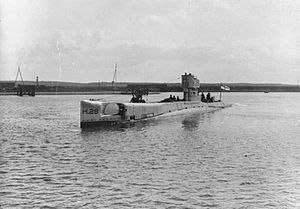HMS H28
 |
|
| History | |
|---|---|
| Name: | HMS H28 |
| Builder: | Vickers Limited, Barrow-in-Furness |
| Laid down: | 18 March 1917 |
| Commissioned: | 29 June 1918 |
| Fate: | Scrapped, 18 August 1944 |
| General characteristics | |
| Class and type: | H class submarine |
| Displacement: |
|
| Length: | 171 ft 0 in (52.12 m) |
| Beam: | 15 ft 4 in (4.67 m) |
| Propulsion: |
|
| Speed: |
|
| Range: |
|
| Complement: | 22 |
| Armament: |
|
HMS H28 was a British H class submarine built by Vickers Limited, Barrow-in-Furness, as part of the Batch 3 H class submarines. She was laid down on 18 March 1917 and was commissioned on 29 June 1918.
HMS H28 collided with a steamer in the Bruges Canal in May 1929.
H28 was scrapped on 18 August 1944 and was broken up in Troon.
Like all post-H20 British H-class submarines, H28 had a displacement of 440 tonnes (490 short tons) at the surface and 500 tonnes (550 short tons) while submerged. It had a total length of 171 feet (52 m), a beam length of 15 feet 4 inches (4.67 m), and a draught length of 12 metres (39 ft). It contained a diesel engines providing a total power of 480 horsepower (360 kW) and two electric motors each providing 320 horsepower (240 kW) power. The use of its electric motors made the submarine travel at 11 knots (20 km/h; 13 mph). It would normally carry 16.4 tonnes (18.1 short tons) of fuel and had a maximum capacity of 18 tonnes (20 short tons).
The submarine had a maximum surface speed of 13 knots (24 km/h; 15 mph) and a submerged speed of 10.5 knots (19.4 km/h; 12.1 mph). Post-H20 British H-class submarines had ranges of 2,985 nautical miles (5,528 km; 3,435 mi) at speeds of 7.5 knots (13.9 km/h; 8.6 mph) when surfaced.H28 was fitted with an anti-aircraft gun and four 21 inches (530 mm) torpedo tubes. Its torpedo tubes were fitted to the bows and the submarine was loaded with eight 21 inches (530 mm) torpedoes. It is a Holland 602 type submarine but was designed to meet Royal Navy specifications. Its complement was twenty-two crew members.
...
Wikipedia
